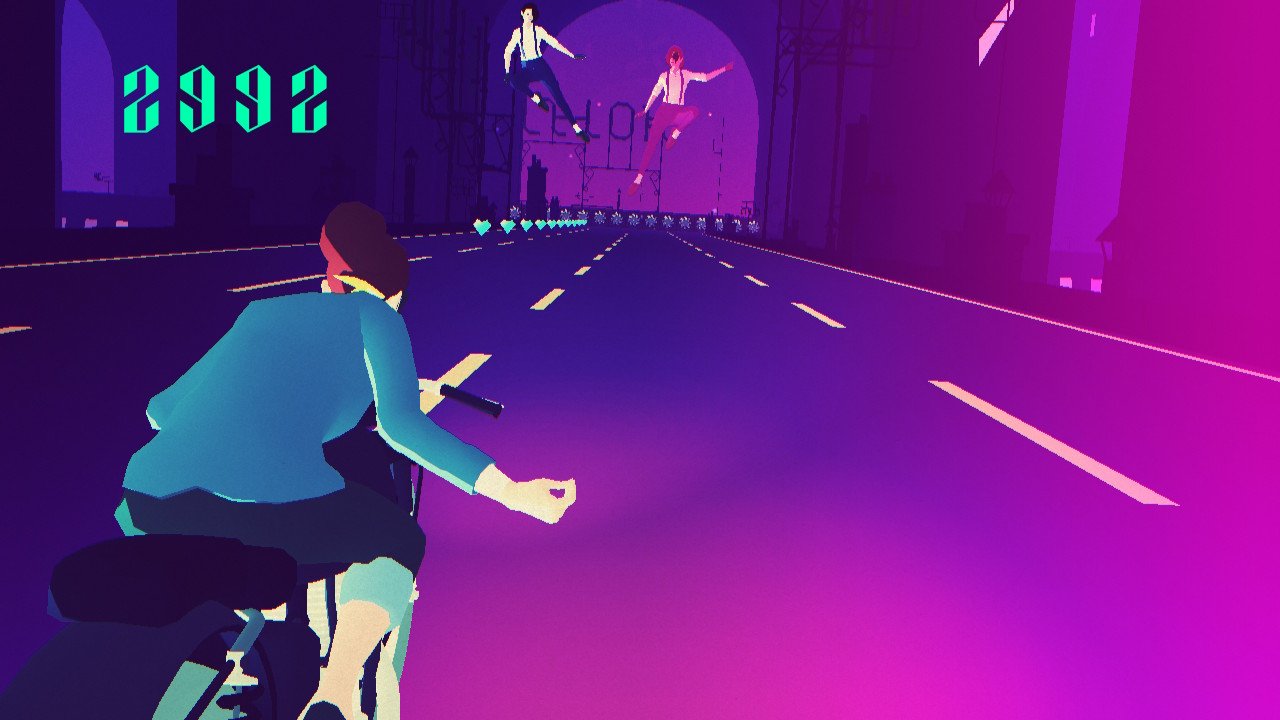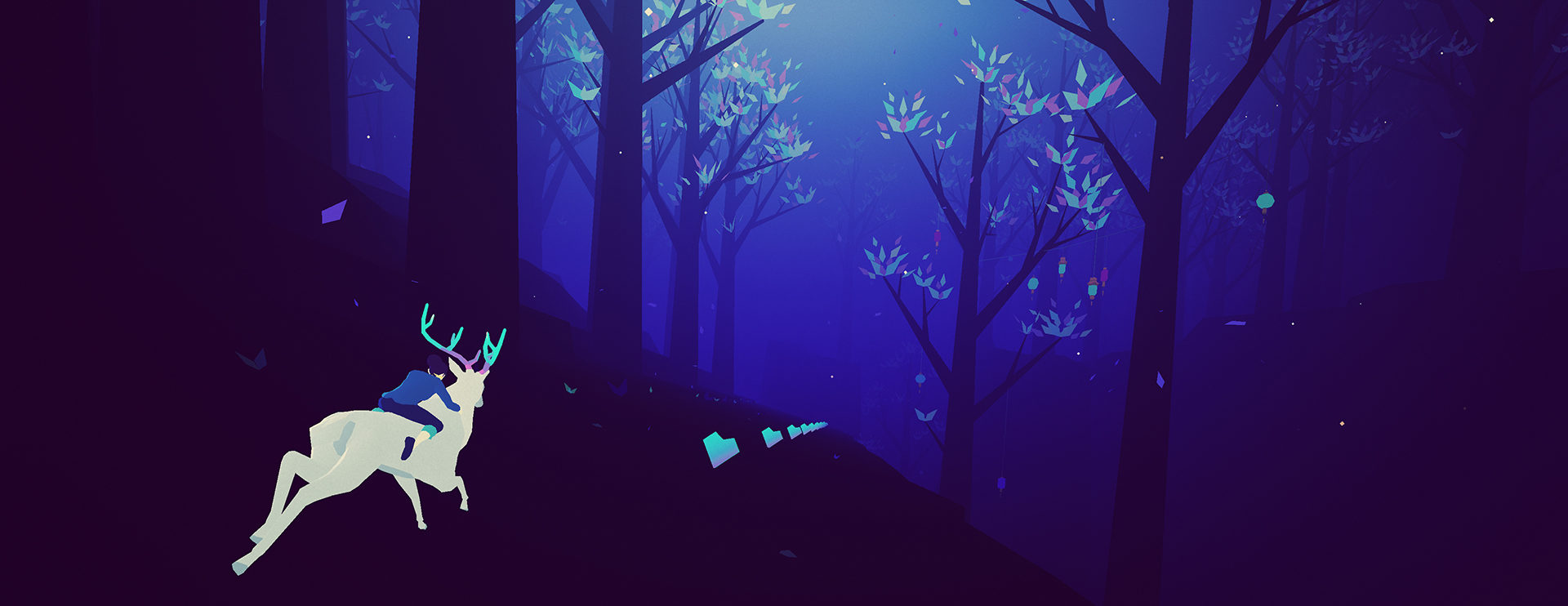Video games and music go hand-in-hand. It’s hard to imagine Mario Bros. without its iconic soundtrack or a Final Fantasy game without the series’ beloved victory fanfare. Still, many developers seem unsure how to approach the music in their games. A project that leans too heavily on music typically becomes a rhythm game, defined almost solely by its audio. Don’t focus on it enough, though, and a great score can simply fade into the background, woefully underutilized. Equilibrium has rarely been found when it comes to making music a meaningful part of interactive media. Sayonara Wild Hearts, the latest game from the Swedish indie studio Simogo, looks to change that.
Sayonara Wild Hearts doesn’t follow its own dreamy, ethereal music so much as becomes it. You aren’t parroting notes on screen or dancing to the beat but watching it weave its own narrative throughout neon-soaked tunnels and across rainbow highways rife with hearts and motorcycles. In an industry that often either sees music as either a background necessity or simplistic gameplay mechanic, Sayonara Wild Hearts crafts its entire universe around its tracks.

Equal parts psychedelic trip and anime romance in the vein of “Sailor Moon, the teddy girls subculture, café race culture and video game tropes,” according to Simogo co-founder Simon Flesser, Sayonara Wild Hearts is a sugary sweet thrill ride. It’s dressed up in bubblegum pinks and screaming blues, all with a seasoning of pop culture. It’s also a side-scrolling shooter, racer, arcade game, and rail shooter—a fluid, ever-changing enigma that transforms as its accompanying pop music tracks melt into one another.
The narrative is purposefully vague, built less on plot points and more on thematic elements that ebb and flow with the music. It follows a young woman whose heart is breaking, which “disturbs” the balance of the universe. When a shimmering diamond butterfly appears in her dreams, she’s able to travel to a looping, seemingly endless highway in the sky, where she finds her other self.
Transforming into the masked biker known as The Fool, the young woman sets out to bring harmony to the universe as well as herself. Standing in her way are the malevolent Little Death and her band of merry allies, including the whirling Dancing Devils, the wolf-like Howling Moons, the twins Stereo Lovers, and the gaming-obsessed VR fanatic Hermit 64.
Like Pink Floyd’s The Wall or Queens of the Stone Age’s …Like Clockwork, Sayonara Wild Hearts is a concept album in game form. You’re more than welcome to play your favorite morsels, but this is a game intended to be enjoyed as a full course meal. It lasts around an hour or so when played consecutively, and it’s even shorter if you end up skipping any sections out of frustration. The brevity makes it easy to experience multiple times—much like you would a favorite record.
It’s easy to digest, too, because it’s such an attractive game with a unique, ultra-stylish vibe that’s not unlike something you’d see in a Persona game. The distinct visual style wasn’t a conscious decision made out of a desire to be unique, but out of necessity.
“We had to find a visual style that would be impactful, but feasible to create with such a small team,” Flesser explained.

Each stage is bathed in its own unique color palette, with cool blues, pinks, and purples for “Heartbreak” areas, or the pathways that connect each stage. Others, like “Parallel Universes,” are bathed in electric oranges and purple that represent the dual worlds of the twins Stereo Lovers as they “snap” back and forth out of dimensions.
“When I hear specific tracks I see specific colors, so the palette of Sayonara Wild Hearts was always quite clear to me,” Flesser said. “Most of the times the tempo of a song would influence the speed of a level. For general moods and scenarios, we’d also sometimes talk about specific things and Daniel [Olsen] would start composing things that would match that.”
Beyond the environmental details, the characters are gorgeous, detailed, and surreal avatars. They’re larger-than-life representations of the challenges the protagonist must face as she tirelessly toils to complete her journey. But despite her trepidation and initial wonder at meeting her other self, The Fool’s movements, as well as her adversaries’, are deliberate and graceful. They’re free from the constraints of gravity, according to Flesser, as the team looked at modern dance and ballet for their poses and as inspiration.
“Also, as a child I saw an episode of Garfield that had a dance battle in an alley, and it’s nice to finally have been able to get that out of my system,” he joked.
But impressive as the visuals are, the accompanying music is the true star of every single part of the game, the common thread that gives Sayonara Wild Hearts its backbone. Each area has a unique soundtrack that appears to match the dominant enemy throughout each one, though that wasn’t even intentional.
“The songs were not written to match the specific characters,”Flesser explained. “Rather we’d try and fit the songs to specific scenarios that would match the characters.” But he noted that each stage’s look was directly inspired by the music.

Each track varies from instrumental to vocal pop and was loosely inspired by the likes of Carly Rae Jepsen’s slinky electropop, the synth stylings of CHVRCHES, and even the manic, high-energy happy hardcore and Eurodance of Blümchen—as well as a number of other artists and styles.
The melodies throughout the game, with lyrics from Jonathan Eng and breathy vocals by Linnea Olsson, are organic in a way that you don’t often see in games, except for perhaps experimental releases like Tetris Effect or the spiritual sequel to Rez, Child of Eden. In fact, Sayonara Wild Hearts takes plenty of inspiration from these games, though despite its visual resemblance in some areas to games like Frequency or Audiosurf, Flesser stated the team had drawn inspiration from a completely different set of titles. He cited Space Harrier and Star Fox as part of a jumping-off point for the design for much of the game. There’s a surprise for Rez fans later on, too.
“We intentionally tried to not have those types of games be a direct influence as we didn’t want to make a game that was deeply tied to the rhythm, but rather make a game in which the flow of the songs would influence the scenarios and actions on screen.”

The game doesn’t follow the music, but creates its own as it goes on. Failure is reduced to that of a simple record scratch. The music grinds to a halt for the briefest moment, but in the blink of an eye you’re back on track careening down a multi-hued road to success. The same musical section that had been playing quickly resumes. You aren’t failing. You’re just finding your groove. Should certain segments prove too difficult or frustrating, you’re faced with the option to skip them, just as if you’d pass over a track on an album.
Every element falls into place seamlessly to create a spectacle of action and sound that fold effortlessly into one another. It may seem as though a herculean effort that required a tremendous amount of planning and alternative game design ideas, but as Flesser said, Simogo’s process here wasn’t that different from their other projects.
“We usually make the music and sometimes make up entire scenarios around songs as they are made,” Flesser said. “What differs mostly for this game is that it has to be so deeply tied to the timing, so it was a lot of back and forth between me and Daniel on some songs.”

Nowhere is this notion made more clear than the “Forest Dub” level, which propels players along with a pulsing beat that ripples throughout the stage while it echoes through the music. Then there’s “Night Drift,” where The Fool jumps behind the wheel of a desert road at twilight in what appears to be a souped-up muscle car, speeding down the winding highway and avoiding obstacles as the music seems to serpentine all its own. These two segments go a long way to exemplify the team’s work to ensure some songs worked in terms of timing.
This emphasis on sound can be chalked up to Flesser’s view that music is “just as important” as a game’s visuals. “I will never understand why some people turn off sound,” he said. “To be honest, that is the same as turning off the visuals to me. So much of a game’s feel comes from its audio.”
As such, Sayonara Wild Hearts is intertwined with its soundtrack in a way that means you simply cannot divorce the two from another. Playing on mute isn’t an option. Sure, technically, you could, but without the music, you may as well be playing a generic runner.
With the sound cranked up, Sayonara Wild Hearts is a neon explosion of gorgeous melodies, bittersweet revelations, and proof that music can be just as important of a thread when developing games as anything else. It’s a symphony of sight and sound, a shimmering holographic playland where the soundtrack becomes one with the visuals.
Header image: Simogo

Brittany Vincent has been covering video games and tech for over a decade for publications like G4, Popular Science, Playboy, Empire, Complex, IGN, GamesRadar, Polygon, Kotaku, Maxim, GameSpot, Variety, Rolling Stone, Yahoo, and more. She’s also appeared as a speaker at video game conventions like PAX East and has coordinated social media for companies like CNET. When she’s not writing or gaming, she’s looking for the next great visual novel in the vein of Saya no Uta. Check out her work at brittanyvincent.com.